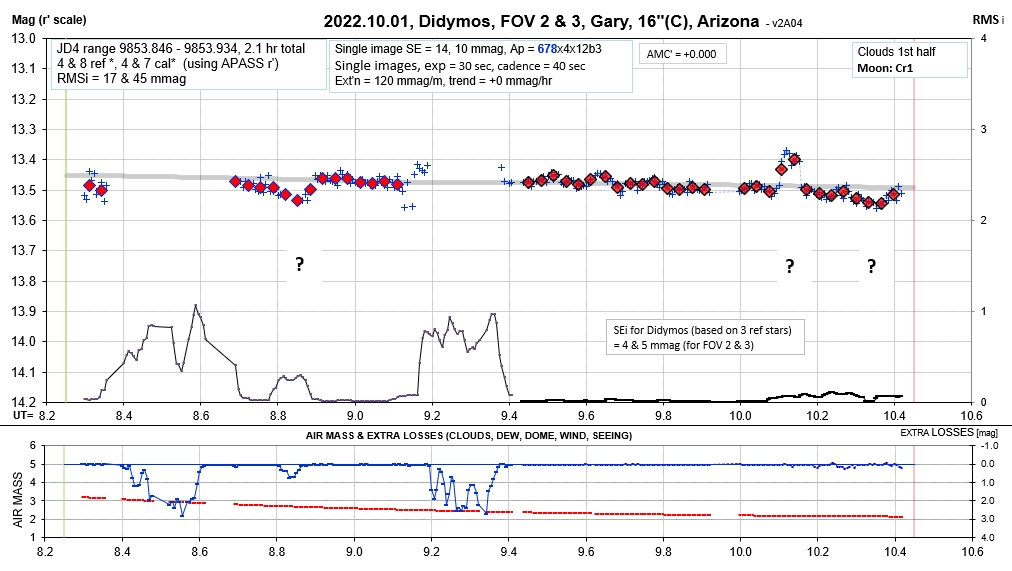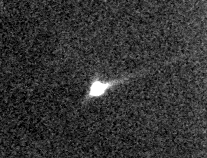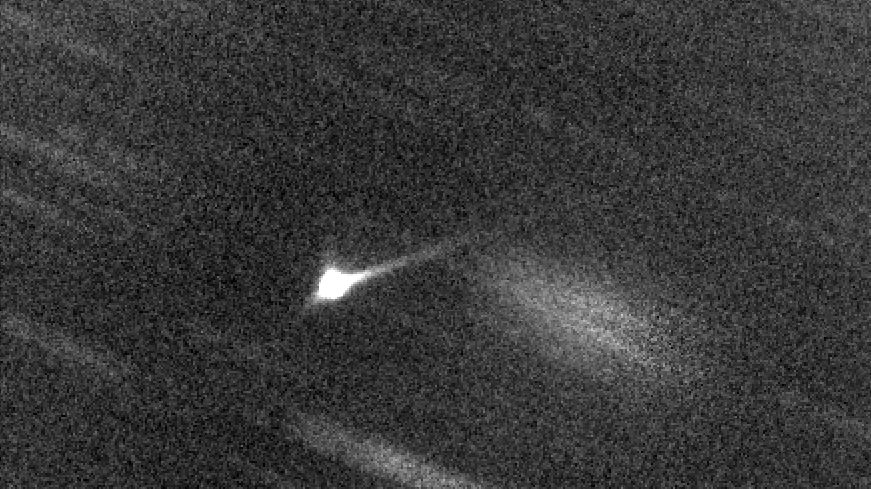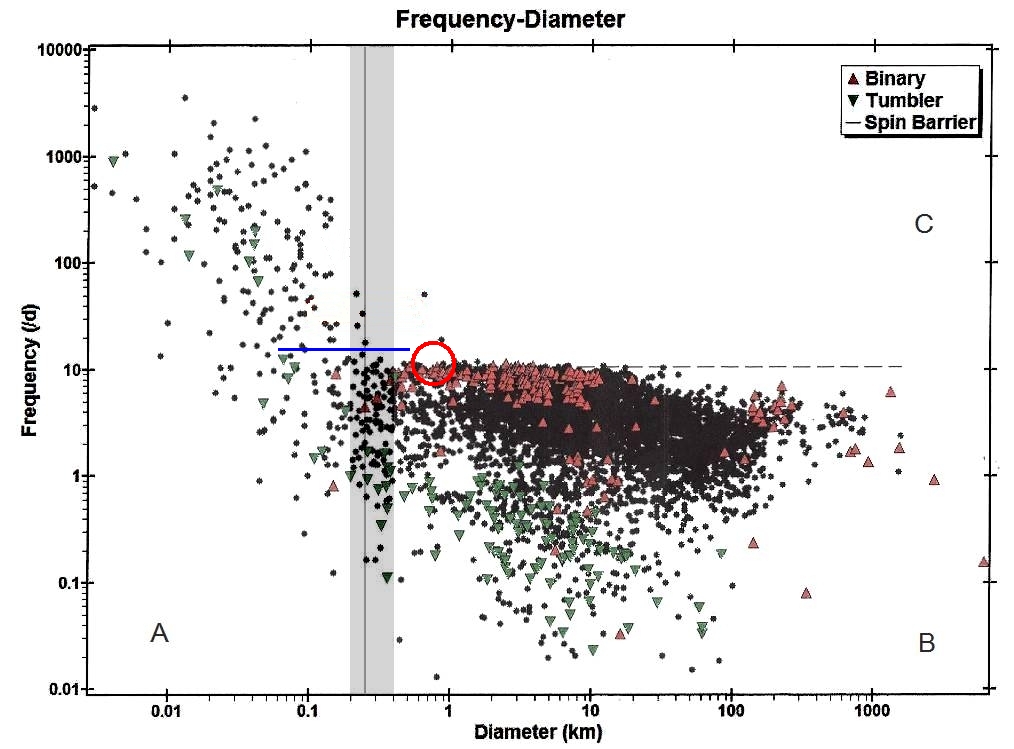B. Gary, Latest Update: 2022.10.24, 05 UT
This web page is no longer being updated due
to lack of interest on my part. Plenty of others, especially on
DART's photometry team, are conducting observations so there's
no need for mine.
I neglected DART's impact of the asteroid Didymos's orbital companion (Dimorphos) until Richard Hoagland asked if I was observing it to detect changes after impact. He suggested that Dimorphos might have been completely destroyed by the impact, and wondered if I could do some observations to confirm this. So I made my first observations Oct 01 (UT) and was able to observe between clouds for ~ 2 hrs. Here's what I found:

Figure 1. Light curve for a 2-hour observing session. The "?" symbol indicates onset of a fade.
I neglected DART's impact of the asteroid Didymos's orbital companion (Dimorphos) until Richard Hoagland asked if I was observing it to detect changes after impact. He suggested that Dimorphos might have been completely destroyed by the impact, and wondered if I could do some observations to confirm this. So I made my first observations Oct 01 (UT) and was able to observe between clouds for ~ 2 hrs. Here's what I found:

Figure 1. Light curve for a 2-hour observing session. The "?" symbol indicates onset of a fade.
Three features are of
interest in this light curve: 1) a possible fade at 8.85 UT,
2) a possible brightening at 10.12 UT, and 3) a possible fade
starting after the brightening. (A
wild speculation: Features 2 and 3 are due to an orbiting dust
cloud producing forward scattering brightening before it
occults Didymos.)
After more image sets are available I will try to derive a Didymos rotation curve. The Didymos rotation variation can be obtained by phase-folding with a 2.26-hr period, and deriving a smoothed brightest-value curve. After subtracting that curve from a LC like the one above the residuals would contain the eclipse and transit features, which in-turn would allow for eventual determination of the new orbital period for Dimorphos (the smaller asteroid, that one that was impacted).
Update: October 2 (2nd observing session)

Figure 2. Light curve for 3 hours on October 02.
Maybe this 1/2-hr, 3 % fade (centered on 9.11 UT) is a transit or eclipse, that can eventually be used to determine if the DART mission objective was achieved. All of my graphs have been submitted to the DART team, which must be busily working away with all their LC observations to solve this complicated problem.
A trailing tail is present; maybe sideways and leading ones are also present.

Figure 3. 3.5-minute of exposure. North up, east left. FOV = 4.4 x 3.3 'arc. Asteroid motion is to left and slightly up (e.g., ENE).
Update: October 3 (3rd observing session)

Figure 4. Light curve for 3 hours on October 03.
There's a fade feature from 9.3 to 10.4 UT (centered on 9.85 UT) with depth ~ 9 %. It's different in length and depth compared with the fade feature on the previous day so they are probably not associated with the same eclipse (or transit). I have no idea how to explain them..

Figure 5. Still 3 tails, the longest one is 4.5 'arc long. North up, east left. FOV = 9.4x5.3 'arc.
This image can be compared with an image taken with a 4.1-m telescope in Chile (SOAR observatory), link1 and link2.
A Disturbing Thought
Didymos is rotating slightly faster than the "spin barrier" for rubble pile asteroids. This is shown in the next graph:

Figure 5. Scatter diagram for many asteroids showing rotation rate vs. diameter. The spin rate of ~ 10 rotations per day (P_rot = 2.40 hours) is referred to as a "spin barrier." Faster spinning rubble-pile asteroids have insufficient gravity to overcome centrifugal forces, meaning that they disintegrate, spewing rubble in all directions (in its equatorial plane), and eventually disappear. The red circle is the location of Didymos (pre-impact).The blue line shows the track Didymos would take toward disintegration if it's spin rate were to increase slightly (from 10.6 rotations/day to whatever destabilizes it).
Didymos is already sitting on the "spin barrier" (red circle in above figure), and a small increase in its spin rate would force it to be on a "disintegration runaway" track (leftward, along the blue line in figure). While on this track Didymos would have insufficient gravity to hold itself together as it spun itself apart while shedding debris into a disk that could extend to beyond its Hill sphere (e.g., producing long tails in several azimuthal directions). This debris field could endure until it disappeared by dispersal into interplanetary space (contributing to the Gegenschein). During this mass loss process the orbit of Dimorphos would grow larger, with longer periods, until it too would fling itself free of Didymos. All of these behaviors would be observable from Earth, so it's just a matter of time before we'll know if the entire Didymos/Dimorphos system is destined for disintegration and disappearance.
References
Pravec, P., C. A. Thomas and 8 others, 2022, "Photometric Observations of the Binary Near-Earth Asteroid (65803) Didymos in 2015-2021 Prior to DART," The Planetary Science J., 3, 175 link
B.Gary home page
________________________________________________________________
After more image sets are available I will try to derive a Didymos rotation curve. The Didymos rotation variation can be obtained by phase-folding with a 2.26-hr period, and deriving a smoothed brightest-value curve. After subtracting that curve from a LC like the one above the residuals would contain the eclipse and transit features, which in-turn would allow for eventual determination of the new orbital period for Dimorphos (the smaller asteroid, that one that was impacted).
Update: October 2 (2nd observing session)

Figure 2. Light curve for 3 hours on October 02.
Maybe this 1/2-hr, 3 % fade (centered on 9.11 UT) is a transit or eclipse, that can eventually be used to determine if the DART mission objective was achieved. All of my graphs have been submitted to the DART team, which must be busily working away with all their LC observations to solve this complicated problem.
A trailing tail is present; maybe sideways and leading ones are also present.

Figure 3. 3.5-minute of exposure. North up, east left. FOV = 4.4 x 3.3 'arc. Asteroid motion is to left and slightly up (e.g., ENE).
Update: October 3 (3rd observing session)

Figure 4. Light curve for 3 hours on October 03.
There's a fade feature from 9.3 to 10.4 UT (centered on 9.85 UT) with depth ~ 9 %. It's different in length and depth compared with the fade feature on the previous day so they are probably not associated with the same eclipse (or transit). I have no idea how to explain them..

Figure 5. Still 3 tails, the longest one is 4.5 'arc long. North up, east left. FOV = 9.4x5.3 'arc.
This image can be compared with an image taken with a 4.1-m telescope in Chile (SOAR observatory), link1 and link2.
A Disturbing Thought
Didymos is rotating slightly faster than the "spin barrier" for rubble pile asteroids. This is shown in the next graph:

Figure 5. Scatter diagram for many asteroids showing rotation rate vs. diameter. The spin rate of ~ 10 rotations per day (P_rot = 2.40 hours) is referred to as a "spin barrier." Faster spinning rubble-pile asteroids have insufficient gravity to overcome centrifugal forces, meaning that they disintegrate, spewing rubble in all directions (in its equatorial plane), and eventually disappear. The red circle is the location of Didymos (pre-impact).The blue line shows the track Didymos would take toward disintegration if it's spin rate were to increase slightly (from 10.6 rotations/day to whatever destabilizes it).
Didymos is already sitting on the "spin barrier" (red circle in above figure), and a small increase in its spin rate would force it to be on a "disintegration runaway" track (leftward, along the blue line in figure). While on this track Didymos would have insufficient gravity to hold itself together as it spun itself apart while shedding debris into a disk that could extend to beyond its Hill sphere (e.g., producing long tails in several azimuthal directions). This debris field could endure until it disappeared by dispersal into interplanetary space (contributing to the Gegenschein). During this mass loss process the orbit of Dimorphos would grow larger, with longer periods, until it too would fling itself free of Didymos. All of these behaviors would be observable from Earth, so it's just a matter of time before we'll know if the entire Didymos/Dimorphos system is destined for disintegration and disappearance.
References
Pravec, P., C. A. Thomas and 8 others, 2022, "Photometric Observations of the Binary Near-Earth Asteroid (65803) Didymos in 2015-2021 Prior to DART," The Planetary Science J., 3, 175 link
B.Gary home page